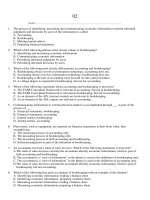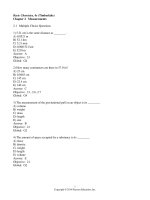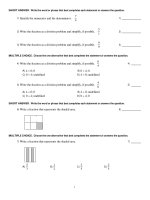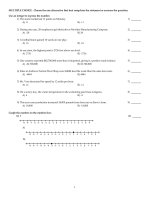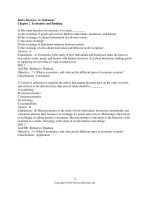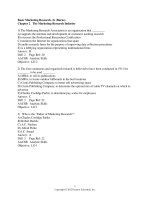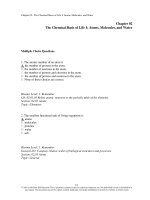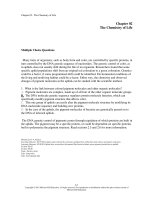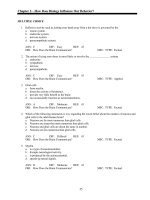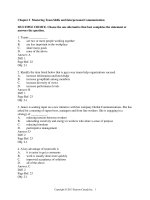Chemistry 3rd edition burdge test bank
Bạn đang xem bản rút gọn của tài liệu. Xem và tải ngay bản đầy đủ của tài liệu tại đây (212.41 KB, 16 trang )
Chapter 2 Atoms, Molecules, and Ions
1. What name is given to the concept that different samples of a given compound always
contain the same elements in the same mass ratio?
A) Ration Law
D) Law of Definite Proportions
B) Law of Equality
E) Second Law of Thermodynamics
C) First Law of Thermodynamics
Ans: D Bloom's Taxonomy: 1 Difficulty: easy
2. The scientist who determined the magnitude of the electric charge of the electron was
A) John Dalton.
D) Henry Moseley.
B) Robert Millikan.
E) J. Burdge.
C) J. J. Thomson.
Ans: B Bloom's Taxonomy: 1 Difficulty: easy
3. When J. J. Thomson discovered the electron, what physical property of the electron did
he measure?
A) its charge, e
D) its mass, m
B) its charge–to–mass ratio, e/m
E) its atomic number, Z
C) its temperature, T
Ans: B Bloom's Taxonomy: 1 Difficulty: easy
4. Which field of study made a large contribution toward understanding the composition of
the atom?
A) electricity
D) electrochemistry
B) radiation
E) quantum mechanics
C) solution chemistry
Ans: B Bloom's Taxonomy: 1 Difficulty: easy
5. Which of the following is a type of radioactive radiation which has no charge and is
unaffected by external electric or magnetic fields?
A) rays B) rays C) rays D) rays E) rays
Ans: C Bloom's Taxonomy: 1 Difficulty: easy
6. Which of the following is a type of radioactive radiation that consists of positively
charged particles that are deflected away from a positively charged plate?
A) rays B) rays C) rays D) rays E) rays
Ans: A Bloom's Taxonomy: 1 Difficulty: easy
7. Which of the following is a type of radioactive radiation that consists of electrons and is
deflected away from a negatively charged plate?
A) rays B) rays C) rays D) rays E) rays
Ans: B Bloom's Taxonomy: 1 Difficulty: easy
Page 15
Chapter 2 Atoms, Molecules, and Ions
8. Which of these scientists developed the nuclear model of the atom?
A) John Dalton
D) Henry Moseley
B) Robert Millikan
E) Ernest Rutherford
C) J. J. Thomson
Ans: E Bloom's Taxonomy: 1 Difficulty: easy
9. Rutherford's experiment with alpha particle scattering by gold foil established that
A) protons are not evenly distributed throughout an atom.
B) electrons have a negative charge.
C) electrons have a positive charge.
D) atoms are made of protons, neutrons, and electrons.
E) protons are 1840 times heavier than electrons.
Ans: A Bloom's Taxonomy: 2 Difficulty: moderate
10. J. J. Thomson studied cathode ray particles (electrons) and was able to measure the
mass/charge ratio. His results showed that
A) the mass/charge ratio varied as the cathode material was changed.
B) the charge was always a whole–number multiple of some minimum charge.
C) matter included particles much smaller than the atom.
D) atoms contained dense areas of positive charge.
E) atoms are largely empty space.
Ans: B Bloom's Taxonomy: 2 Difficulty: moderate
11. Who is credited with measuring the mass/charge ratio of the electron?
A) Dalton B) Chadwick C) Thomson D) Millikan E) Rutherford
Ans: C Bloom's Taxonomy: 1 Difficulty: easy
12. Who is credited with first measuring the charge of the electron?
A) Dalton B) Gay–Lussac C) Thomson D) Millikan E) Rutherford
Ans: D Bloom's Taxonomy: 1 Difficulty: easy
13. Millikan's oil–drop experiment
A) established the charge on an electron.
B) showed that all oil drops carried the same charge.
C) provided support for the nuclear model of the atom.
D) suggested that some oil drops carried fractional numbers of electrons.
E) suggested the presence of a neutral particle in the atom.
Ans: A Bloom's Taxonomy: 2 Difficulty: moderate
14. Who is credited with discovering the atomic nucleus?
A) Dalton B) Gay–Lussac C) Thomson D) Chadwick
Ans: E Bloom's Taxonomy: 1 Difficulty: easy
Page 16
E) Rutherford
Chapter 2 Atoms, Molecules, and Ions
15. Rutherford bombarded gold foil with alpha () particles and found that a small
percentage of the particles were deflected. Which of the following was not accounted
for by the model he proposed for the structure of atoms?
A) the small size of the nucleus
B) the charge on the nucleus
C) the total mass of the atom
D) the existence of protons
E) the presence of electrons outside the nucleus
Ans: C Bloom's Taxonomy: 2 Difficulty: moderate
16. Which one of the following statements about atoms and subatomic particles is correct?
A) Rutherford discovered the atomic nucleus by bombarding gold foil with electrons.
B) The proton and the neutron have identical masses.
C) The neutron's mass is equal to that of a proton plus an electron.
D) A neutral atom contains equal numbers of protons and electrons.
E) An atomic nucleus contains equal numbers of protons and neutrons.
Ans: D Bloom's Taxonomy: 2 Difficulty: difficult
17. Who discovered the subatomic particle having a neutral charge the neutron?
A) Millikan B) Dalton C) Chadwick D) Rutherford E) Thomson
Ans: C Bloom's Taxonomy: 1 Difficulty: easy
18. What is the name used to represent the number of protons in the nucleus of each atom of
an element and is equal to the number of electrons outside the nucleus?
A) isotope number
D) atomic number
B) mass number
E) atomic mass units
C) mass–to–charge ratio
Ans: D Bloom's Taxonomy: 1 Difficulty: easy
19. What is the name used to represent the total number of neutrons and protons in the
nucleus of each atom of an element?
A) isotope number
D) atomic number
B) mass number
E) atomic mass units
C) mass–to–charge ratio
Ans: B Bloom's Taxonomy: 1 Difficulty: easy
20. Bromine is the only nonmetal that is a liquid at room temperature. Consider the isotope
81
bromine–81, 35
Br . Select the combination which lists the correct atomic number,
neutron number, and mass number, respectively.
A) 35, 46, 81
B) 35, 81, 46
C) 81, 46, 35
D) 46, 81, 35
E) 35, 81, 116
Ans: A Bloom's Taxonomy: 3 Difficulty: moderate
Page 17
Chapter 2 Atoms, Molecules, and Ions
21. Atoms X, Y, Z, and R have the following nuclear compositions:
410
410
412
412
186 X
183Y
186 Z
185 R
Which two are isotopes?
A) X & Y B) X & R C) Y & R D) Z & R E) X & Z
Ans: E Bloom's Taxonomy: 3 Difficulty: moderate
22. Atoms of the same element with different mass numbers are called
A) ions.
B) neutrons.
C) allotropes.
D) chemical families.
E) isotopes.
Ans: E Bloom's Taxonomy: 1 Difficulty: easy
23. How many neutrons are there in an atom of lead whose mass number is 208?
A) 82 B) 126 C) 208 D) 290 E) none of the above
Ans: B Bloom's Taxonomy: 3 Difficulty: moderate
24. An atom of the isotope sulfur–31 consists of how many protons, neutrons, and
electrons?
A) 15 protons, 16 neutrons, 15 electrons D) 32 protons, 31 neutrons, 32 electrons
B) 16 protons, 15 neutrons, 16 electrons E) 16 protons, 16 neutrons, 15 electrons
C) 16 protons, 31 neutrons, 16 electrons
Ans: B Bloom's Taxonomy: 3 Difficulty: moderate
25. Give the number of protons, electrons, and neutrons in one atom of chlorine–37.
A) 37 protons, 37 electrons, 17 neutrons D) 37 protons, 17 electrons, 20 neutrons
B) 17 protons, 17 electrons, 37 neutrons E) 17 protons, 37 electrons, 17 neutrons
C) 17 protons, 17 electrons, 20 neutrons
Ans: C Bloom's Taxonomy: 3 Difficulty: moderate
26. Two isotopes of an element differ only in their
A) symbol.
D) number of protons.
B) atomic number.
E) number of electrons.
C) atomic mass.
Ans: C Bloom's Taxonomy: 1 Difficulty: easy
27. A magnesium ion, Mg2+, has
A) 12 protons and 13 electrons.
D) 24 protons and 22 electrons.
B) 24 protons and 26 electrons.
E) 12 protons and 14 electrons.
C) 12 protons and 10 electrons.
Ans: C Bloom's Taxonomy: 3 Difficulty: difficult
Page 18
Chapter 2 Atoms, Molecules, and Ions
28. An aluminum ion, Al3+, has
A) 13 protons and 13 electrons.
B) 27 protons and 24 electrons.
C) 16 protons and 13 electrons.
Ans: D Bloom's Taxonomy: 3
29. An oxide ion, O2–, has
A) 8 protons and 10 electrons.
B) 10 protons and 8 electrons.
C) 8 protons and 9 electrons.
Ans: A Bloom's Taxonomy: 3
30. A sulfide ion, S2–, has
A) 16 protons and 16 electrons.
B) 32 protons and 16 electrons.
C) 16 protons and 14 electrons.
Ans: D Bloom's Taxonomy: 3
D)
E)
13 protons and 10 electrons.
10 protons and 13 electrons.
Difficulty: difficult
D)
E)
8 protons and 7 electrons.
10 protons and 7 electrons.
Difficulty: difficult
D)
E)
16 protons and 18 electrons.
32 protons and 18 electrons.
Difficulty: difficult
31. How many protons and electrons are present in one Br– ion?
A) 35 protons, 35 electrons
D) 35 protons, 36 electrons
B) 80 protons, 81 electrons
E) 80 protons, 34 electrons
C) 35 protons, 34 electrons
Ans: D Bloom's Taxonomy: 3 Difficulty: difficult
32. The elements in a column of the periodic table are known as
A) metalloids.
B) a period.
C) noble gases.
D) a group.
E) nonmetals.
Ans: D Bloom's Taxonomy: 1 Difficulty: easy
33. Which of these materials are usually poor conductors of heat and electricity?
A) metals
D) alkaline earth metals
B) metalloids
E) alkali metals
C) nonmetals
Ans: C Bloom's Taxonomy: 1 Difficulty: easy
34. Which of these elements is most likely to be a good conductor of electricity?
A) N B) S C) He D) Cl E) Fe
Ans: E Bloom's Taxonomy: 2 Difficulty: difficult
Page 19
Chapter 2 Atoms, Molecules, and Ions
35. Which of the following elements are the least reactive?
A) alkali metals
D) alkaline earth metals
B) noble gases
E) metalloids
C) halogens
Ans: B Bloom's Taxonomy: 1 Difficulty: easy
36. Which of the following is a nonmetal?
A) lithium, Li, Z = 3
D) bismuth, Bi, Z = 83
B) bromine, Br, Z = 35
E) sodium, Na, Z = 11
C) mercury, Hg, Z = 80
Ans: B Bloom's Taxonomy: 2 Difficulty: moderate
37. Which of the following is a metal?
A) nitrogen, N, Z = 7
D) thallium, Tl, Z = 81
B) phosphorus, P, Z = 15
E) silicon, Si, Z = 14
C) arsenic, As, Z = 33
Ans: D Bloom's Taxonomy: 2 Difficulty: moderate
38. Which of the following is a metalloid?
A) carbon, C, Z = 6
D) iridium, Ir, Z = 77
B) sulfur, S, Z = 16
E) bromine, Br, Z = 35
C) germanium, Ge, Z = 32
Ans: C Bloom's Taxonomy: 2 Difficulty: moderate
39. A row of the periodic table is called a
A) group. B) period. C) isotopic mixture. D) family.
Ans: B Bloom's Taxonomy: 1 Difficulty: easy
E) subshell.
40. Which of these elements is chemically similar to magnesium?
A) sulfur B) calcium C) iron D) nickel E) potassium
Ans: B Bloom's Taxonomy: 2 Difficulty: difficult
41. Which of these elements is chemically similar to oxygen?
A) sulfur B) calcium C) iron D) nickel E) potassium
Ans: A Bloom's Taxonomy: 2 Difficulty: difficult
42. Which of these elements is chemically similar to potassium?
A) calcium B) arsenic C) phosphorus D) cerium E) cesium
Ans: E Bloom's Taxonomy: 2 Difficulty: difficult
Page 20
Chapter 2 Atoms, Molecules, and Ions
43. Silicon, which makes up approximately 25% of the Earth's crust by mass, is used widely
in the modern electronics industry. It has three naturally occurring isotopes, 28Si, 29Si,
and 30Si. Calculate the atomic mass of silicon.
Isotope
Isotopic Mass (amu)
Abundance %
28
Si
27.976927
92.23
29
Si
28.976495
4.67
30
Si
29.973770
3.10
A) 29.2252 amu
D) 28.0855 amu
B) 28.9757 amu
E) 27.9801 amu
C) 28.7260 amu
Ans: D Bloom's Taxonomy: 3 Difficulty: difficult
44. Lithium forms compounds which are used in dry cells and storage batteries and in high–
temperature lubricants. It has two naturally occurring isotopes, 6Li (isotopic mass =
6.015121 amu) and 7Li (isotopic mass = 7.016003 amu). Lithium has an atomic mass of
6.9409 amu. What is the percent abundance of lithium–6?
A) 92.50% B) 86.66% C) 46.16% D) 7.503% E) 6.080%
Ans: D Bloom's Taxonomy: 3 Difficulty: difficult
45. What is the name used to define a mass which is exactly equal to 1/12 the mass of one
carbon–12 atom?
A) isotope number
D) atomic number
B) mass number
E) atomic mass units
C) mass–to–charge ratio
Ans: E Bloom's Taxonomy: 1 Difficulty: easy
46. Which of the following cannot exist as a homonuclear diatomic molecule?
A) hydrogen B) phosphorus C) fluorine D) nitrogen E) oxygen
Ans: B Bloom's Taxonomy: 2 Difficulty: difficult
47. Which is the correct definition of a diatomic molecule?
A) A molecule which contains two or more of the same atoms.
B) A molecule which contains two or more different atoms.
C) A molecule which contains two identical atoms.
D) A molecule which contains two different atoms.
E) c and d
Ans: E Bloom's Taxonomy: 1 Difficulty: easy
Page 21
Chapter 2 Atoms, Molecules, and Ions
48. Which is the correct definition of a polyatomic molecule?
A) A molecule which contains two or more of the same atoms.
B) A molecule which contains two or more different atoms.
C) a and b
D) A molecule which contains two identical atoms.
E) A molecule which contains two different atoms.
Ans: D Bloom's Taxonomy: 1 Difficulty: easy
49. Which is the correct definition of a heteronuclear diatomic molecule?
A) A molecule which contains two or more of the same atoms.
B) A molecule which contains two or more different atoms.
C) a and b
D) A molecule which contains two identical atoms.
E) A molecule which contains two different atoms.
Ans: E Bloom's Taxonomy: 1 Difficulty: easy
50. What represents the exact number of atoms of each element in a molecule?
A) chemical formula
D) molecular formula
B) compound
E) atomic formula
C) constitutional formula
Ans: D Bloom's Taxonomy: 1 Difficulty: easy
51. Which of the following are allotropes?
A) diamond and graphite
D) hydrogen and oxygen
B) hydrogen and deuterium
E) none of the above
C) bromine and chlorine
Ans: A Bloom's Taxonomy: 1 Difficulty: moderate
52. Which, if any, of the following elements do not occur in the major classes of organic
compounds?
A) H
B) C
C) N
D) O
E) All the above elements occur in the major classes of organic compounds.
Ans: E Bloom's Taxonomy: 2 Difficulty: moderate
53. What name is given to a class of compounds that generally do not contain carbon?
A) acarbonic compounds
D) inorganic compounds
B) carbonic compounds
E) aldehyde compounds
C) organic compounds
Ans: D Bloom's Taxonomy: 1 Difficulty: easy
Page 22
Chapter 2 Atoms, Molecules, and Ions
54. Which of the following is the empirical formula for hexane, C6H14?
A) C12H28 B) C6H14 C) C3H7 D) CH2.3 E) C0.43H
Ans: C Bloom's Taxonomy: 3 Difficulty: moderate
55. Which of the following is a molecular formula for CH?
A) C2H6
B) C3H9
C) C4H10
D) C6H6
E) None of the answers are correct.
Ans: D Bloom's Taxonomy: 3 Difficulty: moderate
56. An anion is defined as
A) a charged atom or group of atoms with a net negative charge.
B) a stable atom.
C) a group of stable atoms.
D) an atom or group of atoms with a net positive charge.
E) neutral.
Ans: A Bloom's Taxonomy: 1 Difficulty: easy
57. Which one of these species is an ion?
A) B3+ B) NaCl C) He D) 14C E) none of the above
Ans: A Bloom's Taxonomy: 2 Difficulty: moderate
58. Which of these pairs of elements would be most likely to form an ionic compound?
A) P and Br B) Cu and K C) C and O D) O and Zn E) Al and Rb
Ans: D Bloom's Taxonomy: 2 Difficulty: difficult
59. What is the formula for the ionic compound formed by calcium ions and nitrate ions?
A) Ca3N2 B) Ca(NO3)2 C) Ca2NO3 D) Ca2NO2 E) CaNO3
Ans: B Bloom's Taxonomy: 3 Difficulty: moderate
60. What is the formula for the ionic compound formed by calcium and selenium?
A) CaSe B) Ca2Se C) CaSe2 D) Ca3Se E) CaSe3
Ans: A Bloom's Taxonomy: 3 Difficulty: moderate
61. Which one of the following formulas of ionic compounds is the least likely to be
correct?
A) NH4Cl B) Ba(OH)2 C) Na2SO4 D) Ca2NO3 E) Cu(CN)2
Ans: D Bloom's Taxonomy: 4 Difficulty: difficult
62. Which is the correct formula for copper (II) phosphate?
A) Cu2PO4 B) Cu3(PO4)2 C) Cu2PO3 D) Cu(PO4)2
Ans: B Bloom's Taxonomy: 3 Difficulty: moderate
Page 23
E) Cu(PO3)2
Chapter 2 Atoms, Molecules, and Ions
63. What is the name of PCl3?
A) phosphorus chloride
B) phosphoric chloride
C) phosphorus trichlorate
Ans: E Bloom's Taxonomy: 3
D)
E)
trichlorophosphide
phosphorus trichloride
Difficulty: moderate
64. The compound, P4S10, is used in the manufacture of safety matches. What is its name?
A) phosphorus sulfide
D) tetraphosphorus decasulfide
B) phosphoric sulfide
E) phosphorus sulfite
C) phosphorus decasulfide
Ans: D Bloom's Taxonomy: 3 Difficulty: moderate
65. Diiodine pentaoxide is used as an oxidizing agent that converts carbon monoxide to
carbon dioxide. What is its chemical formula?
A) I2O5 B) IO5 C) 2IO5 D) I5O2 E) (IO5)2
Ans: A Bloom's Taxonomy: 3 Difficulty: moderate
66. What is the name of P4Se3?
A) phosphorus selenide
B) phosphorus triselenide
C) tetraphosphorus selenide
Ans: E Bloom's Taxonomy: 3
D)
E)
phosphoric selenide
tetraphosphorus triselenide
Difficulty: moderate
67. What is the name of ClO–?
A) hypochlorite B) chlorate C) chlorite D) perchlorate
Ans: A Bloom's Taxonomy: 3 Difficulty: moderate
E) perchlorite
68. What is the formula for the permanganate ion?
A) MnO2 B) MnO4 C) MgO24 D) Mn 2O7 E) MgO22
Ans: B Bloom's Taxonomy: 3 Difficulty: moderate
69. Tetrasulfur dinitride decomposes explosively when heated. What is its formula?
A) S2N4 B) S4N2 C) 4SN2 D) S4N E) S2N
Ans: B Bloom's Taxonomy: 3 Difficulty: moderate
70. The chemical name for ClO3– is “chlorate ion.” What is the common name for HClO3?
A) hydrochloric acid
D) chlorous acid
B) chloroform
E) chloric acid
C) hydrogen trioxychloride
Ans: E Bloom's Taxonomy: 2 Difficulty: moderate
71. The formula for magnesium sulfate is
A) MnS. B) MgS. C) MnSO3. D) MgSO4. E) MnSO4.
Ans: D Bloom's Taxonomy: 3 Difficulty: moderate
Page 24
Chapter 2 Atoms, Molecules, and Ions
72. The formula for sodium sulfide is
A) NaS. B) K2S. C) NaS2. D) Na2S. E) SeS.
Ans: D Bloom's Taxonomy: 3 Difficulty: moderate
73. The chemical formula for iron (II) nitrate is
A) Fe2(NO3)3. B) Ir(NO2)2. C) Fe2N3. D) Fe(NO3)2.
Ans: D Bloom's Taxonomy: 3 Difficulty: moderate
E) Fe(NO2)2.
74. What is the formula for lead (II) oxide?
A) PbO B) PbO2 C) Pb2O D) PbO4 E) Pb2O3
Ans: A Bloom's Taxonomy: 3 Difficulty: moderate
75. Potassium permanganate is a strong oxidizer that reacts explosively with easily oxidized
materials. What is its formula?
A) KMnO3 B) KMnO4 C) K2MnO4 D) K(MnO4)2 E) K2Mn2O7
Ans: B Bloom's Taxonomy: 3 Difficulty: moderate
76. Ferric oxide is used as a pigment in metal polishing. Which of the following is its
formula?
A) FeO B) Fe2O C) FeO3 D) Fe2O5 E) Fe2O3
Ans: E Bloom's Taxonomy: 3 Difficulty: moderate
77. What is the name of Mn(CO3)2?
A) manganese carbide
B) magnesium (IV) carbonate
C) manganese (II) carbonate
Ans: E Bloom's Taxonomy: 3
D)
E)
magnesium (II) carbonate
manganese (IV) carbonate
Difficulty: moderate
78. Iron (III) chloride hexahydrate is used as a coagulant for sewage and industrial wastes.
What is its formula?
A) Fe(Cl·6H2O)3
D) Fe3Cl(H2O)6
B) Fe3Cl·6H2O
E) FeCl3·6H2O
C) FeCl3(H2O)6
Ans: E Bloom's Taxonomy: 3 Difficulty: difficult
79. Which of the following is the oxoanion of bromine called the bromate ion?
A) BrO3 B) BrO32 C) BrO24 D) BrO2 E) BrO
Ans: A Bloom's Taxonomy: 3 Difficulty: difficult
80. True or False: The mass of a neutron is equal to the mass of a proton plus the mass of
an electron.
Ans: False Bloom's Taxonomy: 1 Difficulty: easy
81. True or False: Almost all the mass of an atom is concentrated in the nucleus.
Ans: True Bloom's Taxonomy: 1 Difficulty: easy
Page 25
Chapter 2 Atoms, Molecules, and Ions
82. True or False: When a beam of alpha particles passes between two electrically charged
plates, the beam is deflected toward the positive plate.
Ans: False Bloom's Taxonomy: 2 Difficulty: moderate
83. True or False: J. J. Thomson suggested the name “radioactivity” to describe the
spontaneous emission of particles and/or radiation.
Ans: False Bloom's Taxonomy: 1 Difficulty: moderate
84. True or False: All neutral atoms of tin have 50 protons and 50 electrons.
Ans: True Bloom's Taxonomy: 2 Difficulty: moderate
85. True or False: Copper (Cu) is a transition metal.
Ans: True Bloom's Taxonomy: 2 Difficulty: moderate
86. True or False: Lead (Pb) is a main–group element.
Ans: True Bloom's Taxonomy: 2 Difficulty: moderate
87. True or False: When an alkali metal combines with a nonmetal, a covalent bond is
normally formed.
Ans: False Bloom's Taxonomy: 2 Difficulty: moderate
88. True or False: An allotrope is a mixture of forms of the same compound that exist in the
same physical state under the same conditions of temperature and pressure.
Ans: False Bloom's Taxonomy: 1 Difficulty: easy
89. True or False: The empirical formula of C6H6 is CH.
Ans: True Bloom's Taxonomy: 3 Difficulty: difficult
90. True or False: An ionizable hydrogen atom is a hydrogen atom that separates from the
molecule when the molecule is dissolved in a solution and becomes a hydrogen ion, H+.
Ans: True Bloom's Taxonomy: 1 Difficulty: easy
91. True or False: Ionic compounds may carry a net positive or negative charge.
Ans: False Bloom's Taxonomy: 2 Difficulty: moderate
92. What is the law that describes different samples of a given compound that always
contain the same elements in the same mass ratio?
Ans: Law of Definite Proportions
Bloom's Taxonomy: 1 Difficulty: easy
93. What is the Law of Conservation of Mass?
Ans: Matter can be neither created nor destroyed.
Bloom's Taxonomy: 1 Difficulty: easy
Page 26
Chapter 2 Atoms, Molecules, and Ions
94. What are the three types of radiation produced by the decay of substances like uranium?
Ans: alpha, beta, and gamma radiation
Bloom's Taxonomy: 1 Difficulty: moderate
95. How many neutrons are in 13C?
Ans: 7
Bloom's Taxonomy: 3 Difficulty: moderate
96. What is the name given for the elements in Group 1A in the periodic table?
Ans: alkali metals
Bloom's Taxonomy: 1 Difficulty: easy
97. What is the name given for the elements in Group 7A in the periodic table?
Ans: halogens
Bloom's Taxonomy: 1 Difficulty: easy
98. Which group is given the name chalcogens?
Ans: Group 6A
Bloom's Taxonomy: 1 Difficulty: easy
99. What name is given to the simplest organic compounds which only contain carbons and
hydrogens?
Ans: hydrocarbons
Bloom's Taxonomy: 1 Difficulty: easy
100. What is the name of Cu2O?
Ans: copper (I) oxide
Bloom's Taxonomy: 3 Difficulty: moderate
101. What is the formula for sodium dichromate?
Ans: Na2Cr2O7
Bloom's Taxonomy: 3 Difficulty: difficult
102. Define ion.
Ans: An ion is an atom or group of atoms that has a net positive or negative charge.
Bloom's Taxonomy: 1 Difficulty: easy
103. ________________ is the emission and transmission of energy through space in the
form of waves.
Ans: Radiation
Bloom's Taxonomy: 1 Difficulty: easy
104. _____________ is the negatively charged plate connected to a high–voltage source.
Ans: Cathode
Bloom's Taxonomy: 1 Difficulty: easy
Page 27
Chapter 2 Atoms, Molecules, and Ions
105. ______________ coined the term radioactivity to describe the spontaneous emission of
particles and/or radiation.
Ans: Marie Curie
Bloom's Taxonomy: 1 Difficulty: easy
106. ______________ are electrons that are deflected away from negatively charged plates.
Ans: particles
Bloom's Taxonomy: 1 Difficulty: easy
107. Fill in the blank spaces and write out all the symbols in the left hand column in full, in
the form AZ X (i.e., include the appropriate values of Z and A as well as the correct
symbol X).
Ans:
Cl
Symbol
…
197
79 Au
…
17 18
17
Au
79
79
35
17
197
79
118
# protons
17
…
# neutrons
18
118
# electrons
…
…
…
20
20
40
20
20 20
20
Ca
Bloom's Taxonomy: 3 Difficulty: difficult
108. ______________ are atoms that have the same atomic number (Z) but different mass
numbers (A).
Ans: Isotopes
Bloom's Taxonomy: 1 Difficulty: easy
109. _____________ have properties that are intermediate between those of metals and
nonmetals.
Ans: Metalloids
Bloom's Taxonomy: 1 Difficulty: easy
110. ____________ are the name given for the elements in Group VIIIA.
Ans: Noble gases
Bloom's Taxonomy: 1 Difficulty: easy
111. _________________ is defined as a mass exactly equal to one–twelfth the mass of one
carbon–12 atom.
Ans: One atomic mass unit
Bloom's Taxonomy: 1 Difficulty: easy
112. _____________ compounds consist of two different elements.
Ans: Binary
Bloom's Taxonomy: 1 Difficulty: easy
Page 28
Chapter 2 Atoms, Molecules, and Ions
113. ________________ are one of two or more distinct forms of an element.
Ans: Allotropes
Bloom's Taxonomy: 1 Difficulty: easy
114. When one of the hydrogen atoms in a molecule is replaced by a group of atoms, this
group of atoms is known as a ________________.
Ans: functional group
Bloom's Taxonomy: 1 Difficulty: moderate
115. Name the three important “laws” that were accounted for by Dalton's atomic theory.
Ans: Laws of Conservation of Mass; Definite Composition; Multiple Proportions
Bloom's Taxonomy: 1 Difficulty: easy
116. Dalton's atomic theory has required some modifications in the light of subsequent
discoveries. For any three appropriate postulates of Dalton's atomic theory: state the
postulate in its original form and in one sentence, describe why the postulate has needed
modification.
Ans: Matter consists of atoms which are indivisible, cannot be created or destroyed.
But, atoms are divisible, as the existence of subatomic particles shows.
Atoms of one element cannot be converted into atoms of another element. They
can be converted in various nuclear reactions, including radioactive decay. Atoms
of an element are identical in mass and other properties. Isotopes of an element
differ in their masses and other properties.
Bloom's Taxonomy: 5 Difficulty: difficult
117. In the early 1900s, Ernest Rutherford performed an experiment with gold foil, targets
and alpha particles to probe the structure of the atoms. He observed that most of these
alpha particles penetrated the foil undeflected. Realizing that atoms are electrically
neutral (that is, they have equal numbers of protons and electrons) and that the mass of a
proton is significantly greater than the mass of an electron, use Rutherford's data to
propose a structural model of an atom
Ans: (Answers will vary.) Atoms are mostly empty space. The mass is concentrated
mostly at the center of the atom.
Bloom's Taxonomy: 5 Difficulty: difficult
118. Describe the contributions of Marie Curie.
Ans: (Note that answers will vary.) Marie Curie discovered two new elements, and is
one of three people to win two Nobel Prizes. She also suggested the term
“radioactivity” to describe the spontaneous emission of particles and/or radiation.
Bloom's Taxonomy: 5 Difficulty: moderate
Page 29
Chapter 2 Atoms, Molecules, and Ions
119. State the two important experimental results (and the names of the responsible
scientists) which enabled the mass of the electron to be determined.
Ans: Thomson measured m/e, the mass–to–charge ratio. Millikan measured e, the
charge. Thus, the mass m could be calculated.
Bloom's Taxonomy: 1 Difficulty: moderate
120. The table below describes four atoms.
Atom A
Number of protons
79
Number of neutrons
118
Number of electrons
79
Atom B
80
120
80
Atom C
80
118
80
Atom D
79
120
79
Which atoms represent the same element?
Ans: Atoms A and D represent the same element. Atoms B and C represent the same
element.
Bloom's Taxonomy: 3 Difficulty: difficult
121. Determine the average atomic mass of boron is the natural abundance of 10B weighing
exactly 10.0129 amu is 19.9% and the natural abundance of 11B weighing exactly
11.0093 amu is 80.1%? Show all your work
Ans: (10.0129)(0.199) + (11.0093)(0.801) = 10.81 amu
Bloom's Taxonomy: 3 Difficulty: difficult
122. Describe the difference between an empirical formula and a molecular formula.
Ans: An empirical formula is the simplest chemical formula that has the smallest
possible whole–number ratio of atoms in the formula and a molecular formula is
the true formula of a molecule which is a whole–number multiple of its empirical
formula.
Bloom's Taxonomy: 2 Difficulty: moderate
123. Explain what is meant by an ionizable hydrogen atom.
Ans: It is one that separates from the molecule upon dissolving and becomes a
hydrogen ion, H+.
Bloom's Taxonomy: 1 Difficulty: easy
124. Describe what is meant by the term functional group in organic chemistry.
Ans: A functional group is a group of atoms that have replaced one of the hydrogen
atoms in an organic compound.
Bloom's Taxonomy: 1 Difficulty: easy
Page 30
